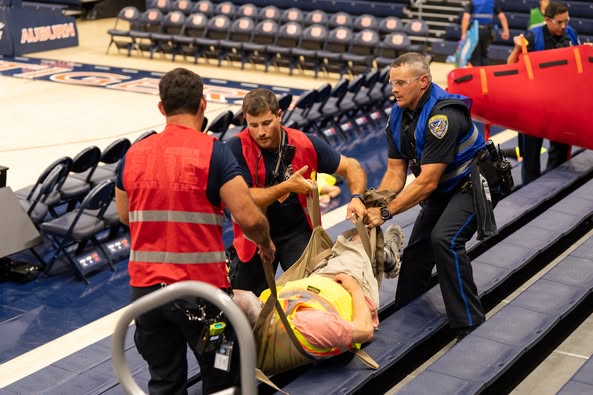MOMENTS THAT MATTER: Auburn’s Live Emergency Drill at Neville Arena Puts Preparedness to the Ultimate Test
AUBURN, AL — In the quiet calm before a simulated storm, the message was clear: seconds save lives. And for two critical days at Auburn University’s Neville Arena, that message became reality. Sirens blared. Radios crackled. First responders sprinted into action. Smoke filled the air, victims cried out, and every second ticked with purpose. But this wasn’t chaos. This was coordination. This was training. This was Auburn preparing for the unthinkable—because when a real crisis strikes, there won’t be time to figure it out.
This was not just another drill. It was a full-scale, live emergency response exercise months in the making. Designed to mimic real-world crises with chilling accuracy, the event brought together Auburn Public Safety, Auburn University Emergency Management, the Lee County Emergency Management Agency, and countless volunteer participants. Together, they transformed Neville Arena from a sports venue into the heart of a high-stakes disaster simulation—testing protocols, communication lines, resource deployment, and human resolve under pressure.
Inside the arena, chaos reigned—but it was controlled, intentional, and painstakingly orchestrated. The objective: pressure-test Auburn’s emergency preparedness systems, expose vulnerabilities, reinforce strengths, and ultimately sharpen the readiness of every agency involved. From law enforcement to paramedics, from university staff to community volunteers, everyone had a role. And everyone understood the weight of what they were practicing for.
Because when real emergencies unfold, there are no second takes.
It’s easy to forget how quickly normal can become catastrophic. A packed event, a medical emergency, a violent threat, a fire—any of these can erupt in a blink. And in that blink, lives hang in the balance. That’s why Auburn’s commitment to safety isn’t theoretical—it’s tactical. It’s why these two days mattered, not just to those in the building, but to everyone who lives, works, and learns in the Auburn community.
The training didn’t just simulate action. It simulated confusion, panic, misinformation—everything that comes with real-world emergency scenarios. Dispatchers dealt with evolving situations in real time. Officers had to make split-second decisions based on limited information. EMTs triaged patients amidst noise and uncertainty. Crisis communication teams practiced how to deliver clear, accurate information while under enormous pressure.
It was, in short, a pressure cooker by design. And that’s what made it so valuable.
The volunteers who posed as victims were more than props. They were vital to creating realism—screaming, crying, going silent, collapsing, reacting. They added the unpredictable human element that every emergency response must contend with. For some first responders, it felt all too real. Muscles tensed. Adrenaline surged. That was the point.
But beneath the simulation’s surface-level chaos was a highly choreographed exercise with deep strategic implications. Each agency had specific objectives. Each move was monitored, logged, and later reviewed. Mistakes were not just allowed—they were expected. They were welcomed. Because finding mistakes now is far better than finding them when it’s too late.
It’s a sobering fact that across the nation, institutions—from schools to concert halls to arenas like Neville—have faced sudden, unimaginable emergencies. Mass casualty events. Natural disasters. Fires. Violent actors. Auburn University and its local agencies refuse to be caught off guard. They’ve made clear that response without preparation is not a plan. It’s a gamble. And Auburn doesn’t gamble with lives.
The decision to hold the drill at Neville Arena was intentional. It’s one of the university’s largest and most high-profile venues. On game nights, it holds thousands. It’s loud, it’s crowded, and it’s complex. In a crisis, it could become both a challenge and a target. Conducting live training in this space allows teams to work with the actual layout, logistics, and limitations of the building. It forces them to ask: Where are the chokepoints? How fast can medics reach the upper levels? How will evacuation routes hold up in a panic? These aren’t academic questions—they’re operational ones.
This kind of training is also invaluable for inter-agency coordination. In a real crisis, no single department stands alone. Police, fire, EMS, university officials, and emergency management personnel must operate as a single, seamless unit. That level of coordination doesn’t happen automatically. It must be built through repetition, feedback, and a shared understanding of each agency’s role. The Neville Arena exercise was a crucial step in building that unified front.
And while the public may only catch glimpses of these drills, they should take comfort in knowing this level of preparation is happening—quietly, seriously, and with relentless attention to detail. The effort is massive. Months of planning. Dozens of meetings. Hundreds of personnel. But the return is immeasurable: lives saved, chaos managed, trust reinforced.
It’s also worth noting the emotional component of these exercises. For first responders, the experience can be intense—even in a simulation. The weight of the scenarios, the screams of victims, the realism of the wounds and the smoke—it all activates the same mental and emotional reflexes that emerge in real emergencies. Some participants leave shaken. That’s expected. And it’s part of why these drills matter. They prepare the mind as much as the body.
Gratitude was abundant in the aftermath. Organizers extended thanks to the countless volunteers who gave their time—and their energy—to make the simulation as authentic as possible. These individuals, playing the roles of injured civilians, panicked bystanders, or even concerned family members, brought heart and soul to the exercise. Their commitment to realism helped first responders hone their instincts in ways that no classroom ever could.
Special recognition also went to Auburn’s Emergency Management team and Lee County EMA for their leadership in crafting the scenarios and managing the complex logistics. It takes vision and discipline to pull off something this large, and Auburn delivered on both.
There is a broader message in all of this: safety is not just a goal. It is a system. It is built before the emergency ever happens. And it is built by people—people who care enough to train, to prepare, to run toward the sound of chaos when others run away.
For the Auburn community, the Neville Arena drill is a reassuring signal. It shows that behind the scenes, a web of highly trained professionals stands ready. It shows that preparation is not optional—it is ongoing, rigorous, and real. And it shows that in the most critical of moments, when seconds matter, Auburn will not hesitate.
Instead, it will respond with strength, unity, and the confidence that only comes from having done the work in advance.
Auburn’s motto—“For the advancement of science and the arts”—is well known. But on these two days, another purpose took center stage: the advancement of safety. Because when it comes to protecting lives, Auburn is not just preparing students. It is preparing heroes.



